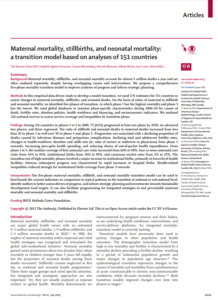
View Resource
Background
Maternal mortality, stillbirths, and neonatal mortality account for almost 5 million deaths a year and are often analysed separately, despite having overlapping causes and interventions. We propose a comprehensive five-phase mortality transition model to improve analyses of progress and inform strategic planning.
Methods
In this empirical data-driven study to develop a model transition, we used UN estimates for 151 countries to assess changes in maternal mortality, stillbirths, and neonatal deaths. On the basis of ratios of maternal to stillbirth and neonatal mortality, we identified five phases of transition, in which phase 1 has the highest mortality and phase 5 has the lowest. We used global databases to examine phase-specific characteristics during 2000–20 for causes of death, fertility rates, abortion policies, health workforce and financing, and socioeconomic indicators. We analysed 326 national surveys to assess service coverage and inequalities by transition phase.
Findings
Among 116 countries in phases 1 to 4 in 2000, 73 (63%) progressed at least one phase by 2020, six advanced two phases, and three regressed. The ratio of stillbirth and neonatal deaths to maternal deaths increased from less than 10 in phase 1 to well over 50 in phase 4 and phase 5. Progression was associated with a declining proportion of deaths caused by infectious diseases and peripartum complications, declining total and adolescent fertility rates, changes in health-workforce densities and skills mix (ie, ratio of nurses or midwives to physicians) from phase 3 onwards, increasing per-capita health spending, and reducing shares of out-of-pocket health expenditures. From phase 1 to 5, the median coverage of first antenatal care visits increased from 66% to 98%, four or more antenatal care visits from 44% to 94%, institutional births from 36% to 99%, and caesarean section rates from 2% to 25%. The transition out of high-mortality phases involved a major increase in institutional births, primarily in lower-level health facilities, whereas subsequent progress was characterised by rapid increases in hospital births. Wealth-related inequalities reduced strongly for institutional birth coverage from phase 3 onwards.
Interpretation
The five-phase maternal mortality, stillbirth, and neonatal mortality transition model can be used to benchmark the current indicators in comparison to typical patterns in the transition at national or sub-national level, identify outliers to better assess drivers of progress, and inform strategic planning and investments towards Sustainable Development Goal targets. It can also facilitate programming for integrated strategies to end preventable maternal mortality and neonatal mortality and stillbirths.